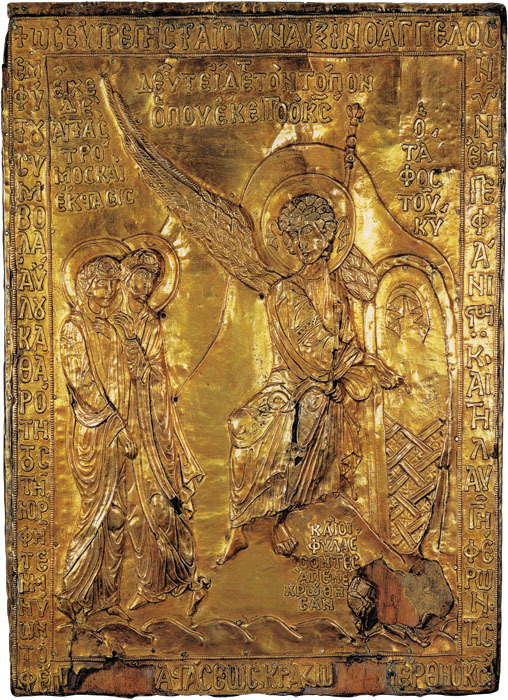The Holy Women Welcomed by the Angel to Christ’s Tomb, plaque of
the reliquary of the stone from Christ’s Sepulchre, 12th century.
Silver gilt over a wooden core, 42.6 x 331 cm. Constantinople,
from the Sainte-Chapelle treasure. Musée du Louvre, Paris
Ornamental Art
Ornamental bronzes
It is solely for the ease of study and classification of the numerous subjects covered in this book that we have separated the statues and bas-reliefs of ornamental bronzes. It is clear that the same hands have contributed to both types of work, and follows a modern aberration against which we must protest. We wanted to divide the productions of intelligence and set up a so-called “high art” in addition to what they term “industrial art”. What? Was Benvenuto Cellini an artist only while modelling the Perseus or The Nymph of Fontainebleau? The marvellous cup of the Louvre, the enamelled goldsmith work, the unparalleled jewellery which have immortalised his name, were these mere industrial works?
The absurdity of such a distinction is needless to demonstrate, it must occur to even the least knowledgeable on the subject. Let us visit the gallery devoted to ancient bronzes in the Louvre. While figures here are certainly in the minority, the fine masks, the palmettes, the acanthus, elegant models which centuries have handed down to us, are no others than the fragments of tripods, chariots, seats, vase-handles, even appendages of culinary utensils. Will we refuse to see the traces of ancient art here? We have seen that mask of Bacchus crowned with ivy and with flowing beard, the ring above it which determines its place among the handles of pegs. Does it deserve to be less admired as one of the finest specimens of Grecian Art?
Let us not then be surprised if we meet with names alluded to elsewhere in the following descriptions. They are those of men who were not afraid to display the variety and pliability of their talent by applying it to diverse objects. We do not attempt to give an idea of the numerous bronze specimens contained in our museums from the tripods, instruments of sacrifice, pill-boxes, candelabras, floor and hanging lamps, even the hooks and vases; each of these decorated with combats between genies and wild beasts or resembling in form the heads of men and women, their hair arranged in various styles. We refer the connoisseur to the special gallery in the Louvre, and to the cabinet of antiquities in the National Library. In the latter they may also admire marvellous Etruscan mirrors which still retain traces of inlaid gold and silver.
We have alluded elsewhere to a statuette of Charlemagne, a work with a much more barbaric impression of the Roman traditions than of the Byzantine deviation. Again in the 12th century, we meet with knight crusaders, even more barbaric in their almost shapeless outlines but clearly allied, at least by the working of the brass, to the curious torches formed of small equestrian figures, in the Spitzer collection. These latter, thoroughly national in character, are analogous to the double candlestick of the 14th century, representing a bearded man in a suit befitting the period of Charles V, wearing peaked shoes and supporting sconce vases with both hands; as also another, wherein a man in a laced doublet, his head covered with a hood, extends both arms also designed to carry lights.
It is also undoubtedly true that artists everywhere knew how to seize ideas susceptible of adaptation and that in their search sometimes led them to the Far East. Were proof required, we need but reference that precious ewer in the Louvre collection in the shape of a peacock to which one would assign an Indian origin. However, the inscription proves the artist: OPUS SALAMONIS FRAT (m). This bird, which stands firmly by the aid of a horseshoe-shaped appendage welded to its feet, is fitted with a curved siphon placed upon its back and surmounted by a small tube, with lid, through which it can be filled. We find this composition common in all warm countries, especially in America; it secures the drinker from all possible intrusion of noxious creatures. This ewer of the 13th century is only a modification of those in the forms of lions, wild animals, or even of groups, as in the Lai d’Aristotle, wherein the philosopher is represented as a steed with a siren, who has charmed and subdued him, mounted on his back.
